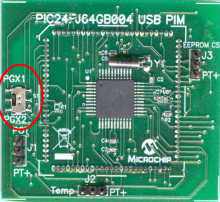Getting Started:
Running the “Host – Bootloaders – Thumbdrive Bootloader” demo
Creating
a hex file to bootload
Required
Hardware:
To run this project, you will need one of the
following sets of hardware:
Configuration 1:
Explorer 16
PIC24FJ256GB110
Plug-In-Module (PIM) (MA240014)
Explorer
16 (DM240001)
USB
PICtail™ Plus Daughter Card (AC164131)
Configuring
the Hardware:
This
section describes how to set up the various configurations of hardware to run
this demo.
Configuration 1: PIC24FJ256GB110 PIM + Explorer 16
Configuration
1: Explorer 16
1)
Before attaching the PIC24FJ256GB110 PIM to the Explorer 16 board, insure that
the processor selector switch (S2) is in the “PIM” position as seen in the
image below.
2)
Short the J7 jumper to the “PIC24” setting
3)
Before connecting the PIC24FJ256GB110 PIM to the Explorer 16 board, remove all
attached cables from both boards. Connect
the PIC24FJ256GB110 PIM to the Explorer 16 board. Be careful when connecting the boards to
insure that no pins are bent or damaged during the process. Also insure that the PIM is not shifted in
any direction and that all of the headers are properly aligned.
3a)
If using the PIC24FJ64GB004 PIM, please insure that the programming port
switch is switched in the PGX1 direction.

4) On the USB PICTail Plus board, short jumpers
JP2 and JP3. Remove all other shorts on
the board.
5) Connect the USB PICTail Plus board to either
of the female PICTail Plus connectors or on the card edge connector (J9) at the
edge of the Explorer 16 board.
The
source code for this demo is available in the “<Install Directory>\USB
Host - Bootloaders\Mass Storage Bootloader” directory. In this directory you will find all of the
user level source and header files as well as project and workspace files for
each of the hardware platforms. Find the
project (*.mcp) or workspace (*.mcw) file that corresponds to the hardware
platform you wish to test. Compile and
program the demo code into the hardware platform. For more help on how to compile and program
projects, please refer to the MPLAB® help available through the help menu of
MPLAB (Help->Topics…->MPLAB IDE).
Creating a hex file to bootload
Any
application in the MCHPFSUSB release can be used to create a hex file the can
be loaded with this bootloader.
In
order to create a new hex file to bootload, follow these steps:
MPLAB 8:
1)
first open up the target project.
2)
Insure that the correct processor is selected in the “Configure->Select
Device” option of MPLAB 8
3)
If there is a linker script already attached to the project, remove it from the
project by right clicking on it and selecting remove.
4)
Copy the appropriate linker file to the demo project folder. The linker files for the thumbdrive
bootloader can be found in the “<install directory>\USB Host -
Bootloaders\Mass Storage Bootloader\Application Files\Linker Files” folder.
5)
Add this file to the project by right clicking on the “linker scripts” folder
in the project window, select “Add Files…”.
Select the correct file.
6)
Compile the project.
7)
Rename the resulting .hex file to “image.hex”.
It is important that the name be exact.
The bootloader is looking for that file specifically by name.
MPLAB X:
1)
first open up the target project.
2)
Select the configuration that corresponds to your demo board.
3)
Copy the appropriate linker file to the demo project folder. The linker files for the thumbdrive
bootloader can be found in the “<install directory>\USB Host -
Bootloaders\Mass Storage Bootloader\Application Files\Linker Files” folder.
4)
Add this file to the project by right clicking on the “linker scripts” folder
in the project window, select “Add Existing Item…”. Select the correct file that corresponds to
the processor that is being used on the demo board.
5)
Compile the project.
6)
Rename the resulting .hex file to “image.hex”.
It is important that the name be exact.
The bootloader is looking for that file specifically by name.
Once
the image.hex file is created through the process listed above, copy this file
onto a thumbdrive. Insert the thumbdrive
into the USB PICtail Plus A connector.
On the Explorer 16, Press and hold the S3 button while resetting the
board by pressing the MCLR button or applying power to the board.
.jpg)
The
D5 LED should illuminate if this is done correctly. The D5 LED should turn itself off once the
bootload process is complete. At this
point of time the application should be running. If you wish to abort a bootload sequence you
can press the S6 switch or power cycle the board.
Trademarks:
The Microchip name and logo, the
Microchip logo, MPLAB, and PIC are registered trademarks of Microchip
Technology Incorporated in the
PICDEM is a trademark of
Microchip Technology Incorporated in the
Microsoft, Windows, and Windows
Vista are either registered trademarks or trademarks of Microsoft Corporation
in the
.JPG)
.JPG)
.JPG)